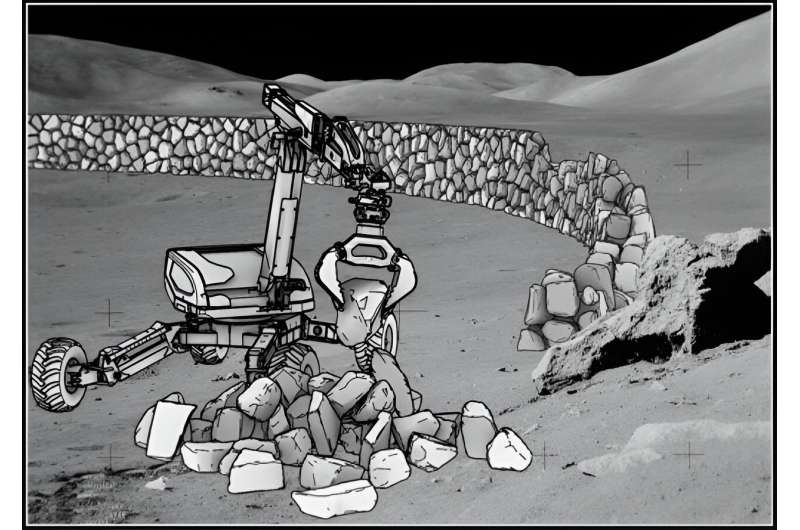
JULY 19, 2024 by Andy Tomaswick, Universe Today
Collected at: https://phys.org/news/2024-07-lunar-infrastructure-autonomously-wall.html
Lunar exploration equipment at any future lunar base is in danger from debris blasted toward it by subsequent lunar landers. This danger isn’t just theoretical—Surveyor III was a lander during the Apollo era that was damaged by Apollo 12’s descent rocket and returned to Earth for closer examination.
Plenty of ideas have been put forward to limit this risk, and we’ve reported on many of them, from constructing landing pads out of melted regolith to 3D printing a blast shield out of available materials. But a new paper published in Frontiers in Space Technologies from researchers in Switzerland suggests a much simpler idea—why not just build a blast wall by stacking a bunch of rocks together?
On the moon, that task isn’t as simple as it sounds. It would require an autonomous excavator to assess the rocks, collect them, and stack them on top of each other so that they wouldn’t fall over. Depending on the size of the rocks, that task could be completed successfully by a toddler, but for a robot, it remained in the realm of science fiction, at least until recently.
Another paper by some of the same co-authors described an autonomous boulder-stacking robot for use in construction projects on Earth. In it, they showed a control algorithm that could successfully stack a rock wall together using medium-sized boulders entirely autonomously. Applying it to lunar construction seemed like the next obvious step.
But first, an excavator would have to make sure there were enough boulders around to build the wall effectively. In the paper, the authors use data from the Lunar Reconnaissance Orbiter to research the distribution of boulders at two potential landing sites—the Shackleton-Henson Connecting Ridge and the Aristarchus Plateau.
They also extrapolate sizes of smaller boulders based on the limits of LRO’s resolution and the distribution law of boulder sizes. Final confirmation came in the form of rock abundance data from another instrument on LRO, with their final estimates agreeing that there should be enough loose material for an autonomous excavator to build a blast wall using locally sourced boulders successfully.
Calculating the amount of material needed to build the blast shield was actually a precursor step to confirming enough boulders were available. It was also necessary for another important calculation—understanding how much energy this process would take compared to alternative solutions of processed stone walls or microwave-heated landing pads. According to the author’s calculations, stacking existing stones is two to three times less energy-intensive than alternatives.
That’s not to say there aren’t still hurdles to overcome. The most obvious is the lack of an autonomous excavator capable of operating on the moon. The one used in the Earth-bound experiments was prohibitively large, and designing a system for use on the Lunar surface is notoriously difficult, with the radiation and the electrostatically charged dust particles. Those electrostatically charged particles could also prove a problem, but further modeling is needed to understand whether lunar boulders would be affected by considerable dust accumulation.
The idea itself is still relatively new, and it does have a lot going for it, given its advantages and the proof of concept demonstration already completed on Earth. So, while there are currently no plans to set up an autonomously constructed rock wall, there is a decent possibility that the idea, or something similar to it, could be picked up as part of the Artemis mission infrastructure. At least the Artemis mission designers will have plenty of potential solutions to this problem, no matter their choice.
More information: Jonas Walther et al, Autonomous construction of lunar infrastructure with in-situ boulders, Frontiers in Space Technologies (2024). DOI: 10.3389/frspt.2024.1345337

Leave a Reply